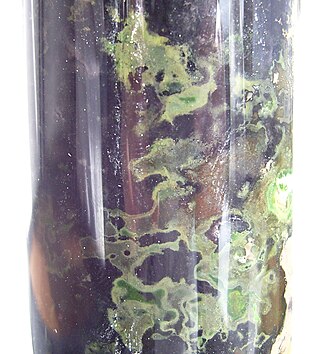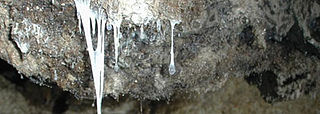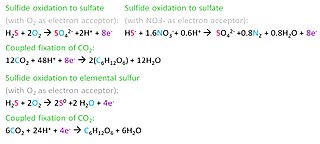Bioleaching is the extraction or liberation of metals from their ores through the use of living organisms. Bioleaching is one of several applications within biohydrometallurgy and several methods are used to treat ores or concentrates containing copper, zinc, lead, arsenic, antimony, nickel, molybdenum, gold, silver, and cobalt.

The green sulfur bacteria are a phylum, Chlorobiota, of obligately anaerobic photoautotrophic bacteria that metabolize sulfur.

Snottite, also snoticle, is a microbial mat of single-celled extremophilic bacteria which hang from the walls and ceilings of caves and are similar to small stalactites, but have the consistency of nasal mucus. In the Frasassi Caves in Italy, over 70% of cells in Snottite have been identified as Acidithiobacillus thiooxidans, with smaller populations including an archaeon in the uncultivated 'G-plasma' clade of Thermoplasmatales (>15%) and a bacterium in the Acidimicrobiaceae family (>5%).
Bacteria biooxidation is an oxidation process caused by microbes where the valuable metal remains in the solid phase. In this process, the metal remains in the solid phase and the liquid can be discarded. Bacterial oxidation is a biohydrometallurgical process developed for pre-cyanidation treatment of refractory gold ores or concentrates. The bacterial culture is a mixed culture of Acidithiobacillus ferrooxidans, Acidithiobacillus thiooxidans and Leptospirillum ferrooxidans. The bacterial oxidation process comprises contacting refractory sulfide ROM ore or concentrate with a strain of the bacterial culture for a suitable treatment period under an optimum operating environment. The bacteria oxidise the sulfide minerals, thus liberating the occluded gold for subsequent recovery via cyanidation.
Thiobacillus is a genus of Gram-negative Betaproteobacteria. Thiobacillus thioparus is the type species of the genus, and the type strain thereof is the StarkeyT strain, isolated by Robert Starkey in the 1930s from a field at Rutgers University in the United States of America. While over 30 "species" have been named in this genus since it was defined by Martinus Beijerinck in 1904,, most names were never validly or effectively published. The remainder were either reclassified into Paracoccus, Starkeya ; Sulfuriferula, Annwoodia, Thiomonas ; Halothiobacillus, Guyparkeria, or Thermithiobacillus or Acidithiobacillus. The very loosely defined "species" Thiobacillus trautweinii was where sulfur oxidising heterotrophs and chemolithoheterotrophs were assigned in the 1910-1960s era, most of which were probably Pseudomonas species. Many species named in this genus were never deposited in service collections and have been lost.

Acidithiobacillus is a genus of the Acidithiobacillia in the phylum "Pseudomonadota". This genus includes ten species of acidophilic microorganisms capable of sulfur and/or iron oxidation: Acidithiobacillus albertensis, Acidithiobacillus caldus, Acidithiobacillus cuprithermicus, Acidithiobacillus ferrianus, Acidithiobacillus ferridurans, Acidithiobacillus ferriphilus, Acidithiobacillus ferrivorans, Acidithiobacillus ferrooxidans, Acidithiobacillus sulfuriphilus, and Acidithiobacillus thiooxidans.A. ferooxidans is the most widely studied of the genus, but A. caldus and A. thiooxidans are also significant in research. Like all "Pseudomonadota", Acidithiobacillus spp. are Gram-negative and non-spore forming. They also play a significant role in the generation of acid mine drainage; a major global environmental challenge within the mining industry. Some species of Acidithiobacillus are utilized in bioleaching and biomining. A portion of the genes that support the survival of these bacteria in acidic environments are presumed to have been obtained by horizontal gene transfer.

Sulfur-reducing bacteria are microorganisms able to reduce elemental sulfur (S0) to hydrogen sulfide (H2S). These microbes use inorganic sulfur compounds as electron acceptors to sustain several activities such as respiration, conserving energy and growth, in absence of oxygen. The final product of these processes, sulfide, has a considerable influence on the chemistry of the environment and, in addition, is used as electron donor for a large variety of microbial metabolisms. Several types of bacteria and many non-methanogenic archaea can reduce sulfur. Microbial sulfur reduction was already shown in early studies, which highlighted the first proof of S0 reduction in a vibrioid bacterium from mud, with sulfur as electron acceptor and H
2 as electron donor. The first pure cultured species of sulfur-reducing bacteria, Desulfuromonas acetoxidans, was discovered in 1976 and described by Pfennig Norbert and Biebel Hanno as an anaerobic sulfur-reducing and acetate-oxidizing bacterium, not able to reduce sulfate. Only few taxa are true sulfur-reducing bacteria, using sulfur reduction as the only or main catabolic reaction. Normally, they couple this reaction with the oxidation of acetate, succinate or other organic compounds. In general, sulfate-reducing bacteria are able to use both sulfate and elemental sulfur as electron acceptors. Thanks to its abundancy and thermodynamic stability, sulfate is the most studied electron acceptor for anaerobic respiration that involves sulfur compounds. Elemental sulfur, however, is very abundant and important, especially in deep-sea hydrothermal vents, hot springs and other extreme environments, making its isolation more difficult. Some bacteria – such as Proteus, Campylobacter, Pseudomonas and Salmonella – have the ability to reduce sulfur, but can also use oxygen and other terminal electron acceptors.
Lithotrophs are a diverse group of organisms using an inorganic substrate to obtain reducing equivalents for use in biosynthesis or energy conservation via aerobic or anaerobic respiration. While lithotrophs in the broader sense include photolithotrophs like plants, chemolithotrophs are exclusively microorganisms; no known macrofauna possesses the ability to use inorganic compounds as electron sources. Macrofauna and lithotrophs can form symbiotic relationships, in which case the lithotrophs are called "prokaryotic symbionts". An example of this is chemolithotrophic bacteria in giant tube worms or plastids, which are organelles within plant cells that may have evolved from photolithotrophic cyanobacteria-like organisms. Chemolithotrophs belong to the domains Bacteria and Archaea. The term "lithotroph" was created from the Greek terms 'lithos' (rock) and 'troph' (consumer), meaning "eaters of rock". Many but not all lithoautotrophs are extremophiles.
Microbial metabolism is the means by which a microbe obtains the energy and nutrients it needs to live and reproduce. Microbes use many different types of metabolic strategies and species can often be differentiated from each other based on metabolic characteristics. The specific metabolic properties of a microbe are the major factors in determining that microbe's ecological niche, and often allow for that microbe to be useful in industrial processes or responsible for biogeochemical cycles.
Biomining ( phytomining) is the concept of extracting metals from ores and other solid materials typically using prokaryotes, fungi or plants (phytoextraction. These organisms secrete organic compounds that chelate metals from the environment. The proposed technology is often aimed at extraction of iron, copper, zinc, gold, uranium, and thorium. Large chemostats of microbes can be grown to leach metals from their media. If it were practical, biomining would be an environmentally friendly alternative to traditional mining.

Thiosulfate dehydrogenase is an enzyme that catalyzes the chemical reaction:
Thermithiobacillus tepidarius is a member of the Acidithiobacillia isolated from the thermal groundwaters of the Roman Baths at Bath, Somerset, United Kingdom. It was previously placed in the genus Thiobacillus. The organism is a moderate thermophile, 43–45 °C (109–113 °F), and an obligate aerobic chemolithotrophic autotroph. Despite having an optimum pH of 6.0–7.5, growth can continue to an acid medium of pH 4.8. Growth can only occur on reduced inorganic sulfur compounds and elementary sulfur, but unlike some species in other genus of the same family, Acidithiobacillus, Thermithiobacillus spp. are unable to oxidise ferrous iron or iron-containing minerals.
Sulfur is metabolized by all organisms, from bacteria and archaea to plants and animals. Sulfur can have an oxidation state from -2 to +6 and is reduced or oxidized by a diverse range of organisms. The element is present in proteins, sulfate esters of polysaccharides, steroids, phenols, and sulfur-containing coenzymes.

The outflow of acidic liquids and other pollutants from mines is often catalysed by acid-loving microorganisms; these are the acidophiles in acid mine drainage.

Rusticyanin (RCN) is a copper protein with a type I copper center that plays an integral role in electron transfer. It can be extracted from the periplasm of the gram-negative bacterium Thiobacillus ferrooxidans, also known as Acidithiobacillus ferrooxidans. Rusticyanin is also found in the membrane-bound form in the surface of T. ferrooxidans. It is a part of an electron transfer chain for Fe(II) oxidation.
Leptospirillum ferriphilum is an iron-oxidising bacterium able to exist in environments of high acidity, high iron concentrations, and moderate to moderately high temperatures. It is one of the species responsible for the generation of acid mine drainage and the principal microbe used in industrial biohydrometallurgy processes to extract metals.
Acidithiobacillus caldus formerly belonged to the genus Thiobacillus prior to 2000, when it was reclassified along with a number of other bacterial species into one of three new genera that better categorize sulfur-oxidizing acidophiles. As a member of the Gammaproteobacteria class of Pseudomonadota, A. caldus may be identified as a Gram-negative bacterium that is frequently found in pairs. Considered to be one of the most common microbes involved in biomining, it is capable of oxidizing reduced inorganic sulfur compounds (RISCs) that form during the breakdown of sulfide minerals. The meaning of the prefix acidi- in the name Acidithiobacillus comes from the Latin word acidus, signifying that members of this genus love a sour, acidic environment. Thio is derived from the Greek word thios and describes the use of sulfur as an energy source, and bacillus describes the shape of these microorganisms, which are small rods. The species name, caldus, is derived from the Latin word for warm or hot, denoting this species' love of a warm environment.
Acidithrix ferrooxidans is a heterotrophic, acidophilic and Gram-positive bacterium from the genus Acidithrix. The type strain of this species, A. ferrooxidans Py-F3, was isolated from an acidic stream draining from a copper mine in Wales. This species grows in a variety of acidic environments such as streams, mines or geothermal sites. Mine lakes with a redoxcline support growth with ferrous iron as the electron donor. "A. ferrooxidans" grows rapidly in macroscopic streamer, producing greater cell densities than other streamer-forming microbes. Use in a bioreactors to remediate mine waste has been proposed due to cell densities and rapid oxidation of ferrous iron oxidation in acidic mine drainage. Exopolysaccharide production during metal substrate metabolism, such as iron oxidation helps to prevent cell encrustation by minerals.

Microbial oxidation of sulfur is the oxidation of sulfur by microorganisms to build their structural components. The oxidation of inorganic compounds is the strategy primarily used by chemolithotrophic microorganisms to obtain energy to survive, grow and reproduce. Some inorganic forms of reduced sulfur, mainly sulfide (H2S/HS−) and elemental sulfur (S0), can be oxidized by chemolithotrophic sulfur-oxidizing prokaryotes, usually coupled to the reduction of oxygen (O2) or nitrate (NO3−). Anaerobic sulfur oxidizers include photolithoautotrophs that obtain their energy from sunlight, hydrogen from sulfide, and carbon from carbon dioxide (CO2).
Thiosocius is a genus of bacteria that lives in symbiosis with the giant shipworm Kuphus polythalamius. It contains a single species, Thiosocius teredinicola, which was isolated from the gills of the shipworm. The specific name derives from the Latin terms teredo (shipworm) and incola (dweller).








